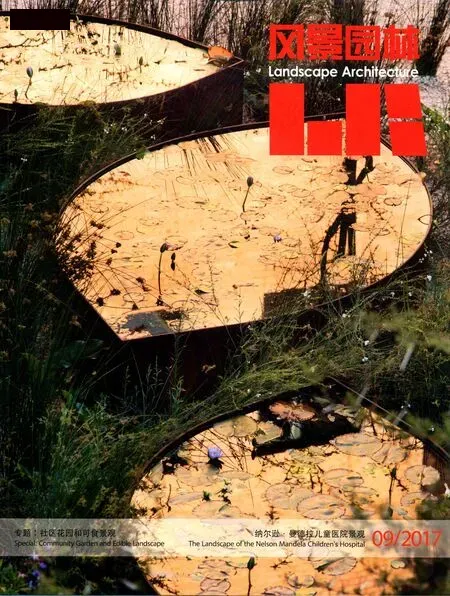纳尔逊·曼德拉儿童医院景观
GREENinc 景观设计事务所
纳尔逊·曼德拉儿童医院景观
GREENinc 景观设计事务所
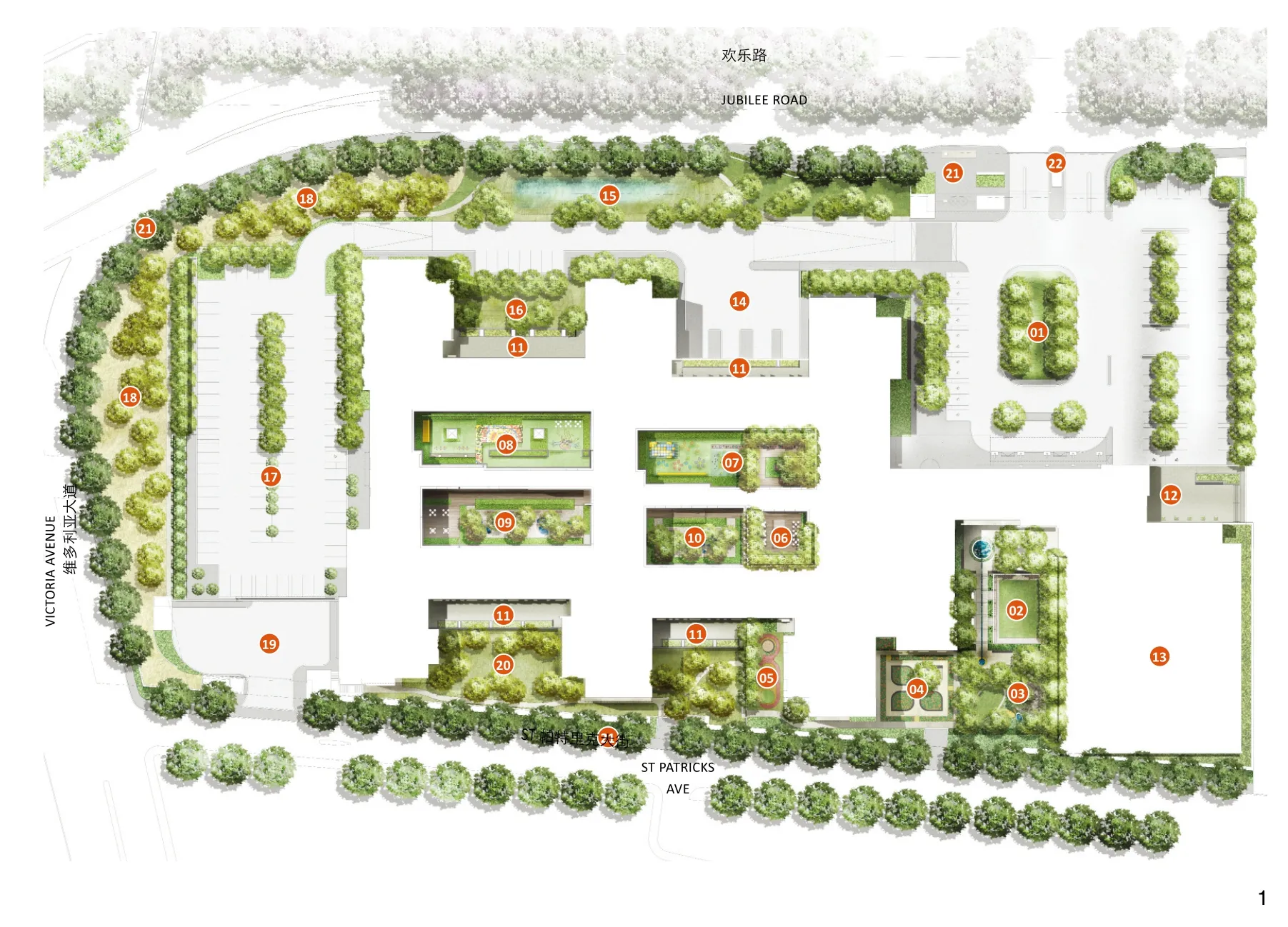
1 平面图Master plan
室外花园EXTERNAL GARDEN ROOMS
01 入口庭院ArrivalCourt
02 游客花园VisitorGarden
03 儿童花园Children’sGarden
04 感官花园(园艺疗法)
SensoryGarden(HorticulturalTherapy)
05 康复治疗花园
OccupationalTherapyGarden
内部庭院花园INTERNAL COURTYARD GARDENS
06 日间花园DayGarden
07 游戏花园PlayGarden
08 家庭花园FamilyGarden
09 治疗花园HealingGarden
10 沉静花园QuietGarden
11 平台花园TerraceGarden
12 学术平台AcademicTerrace
综合景观区GENERAL LANDSCAPE AREAS
13 停车场StructuredParking
14 救护院AmbulanceCourt
15 滞洪池 1AttenuationPond1
16 滞洪池 2AttenuationPond2
17 员工停车场StaffParkingCourt
18 修复景观RehabilitatedLandscape
19 庭院服务区ServicesCourt
20 滞洪池 3AttenuationPond3
21 人行道景观SidewalkLandscape
22 主入口MainEntrance
背景
2011年,我们加入了纳尔逊·曼德拉儿童医院的设计团队,这是一所拥有200个床位的儿童医院,可开展学术研究的三级转诊医院。依照纳尔逊·曼德拉设想,医院完全依靠纳尔逊·曼德拉儿童基金会资助。医院于2016年5月完成施工,2016年12月完成室内设计部分。
康复景观
纳尔逊·曼德拉儿童医院的景观设计(与GREENinc所设计的其他作品一样)坚持基于康复景观设计的理念和原则。在设计具有康复价值的景观时有意通过鼓励患者及其探视、陪护者通过与自然互动的方式来辅助康复治疗。通过在花园中的自主体验及与自然的互动,患者们的内心可以获得一些掌控命运的释然感。同样作为反馈,这种控制感,以及身处花园中的身体运动和社会交往所带来的喜悦,都会缓解压力,最终可缩短康复周期,使患者们身体逐渐恢复健康。
成功的康复景观设计须具备4项核心内容:视觉可达性和物质空间可达性;方便行动困难的人士行走;功能空间满足不同需求;提供感官上的体验。对上述原则的认知和理解,以及与客户、医疗专家和设计专业人员的协商讨论,将共同指导我们进行康复景观设计的各个方面。我们还探讨了前沿的园艺治疗理念,希望通过我们的努力能让医院接受并采纳本方案。
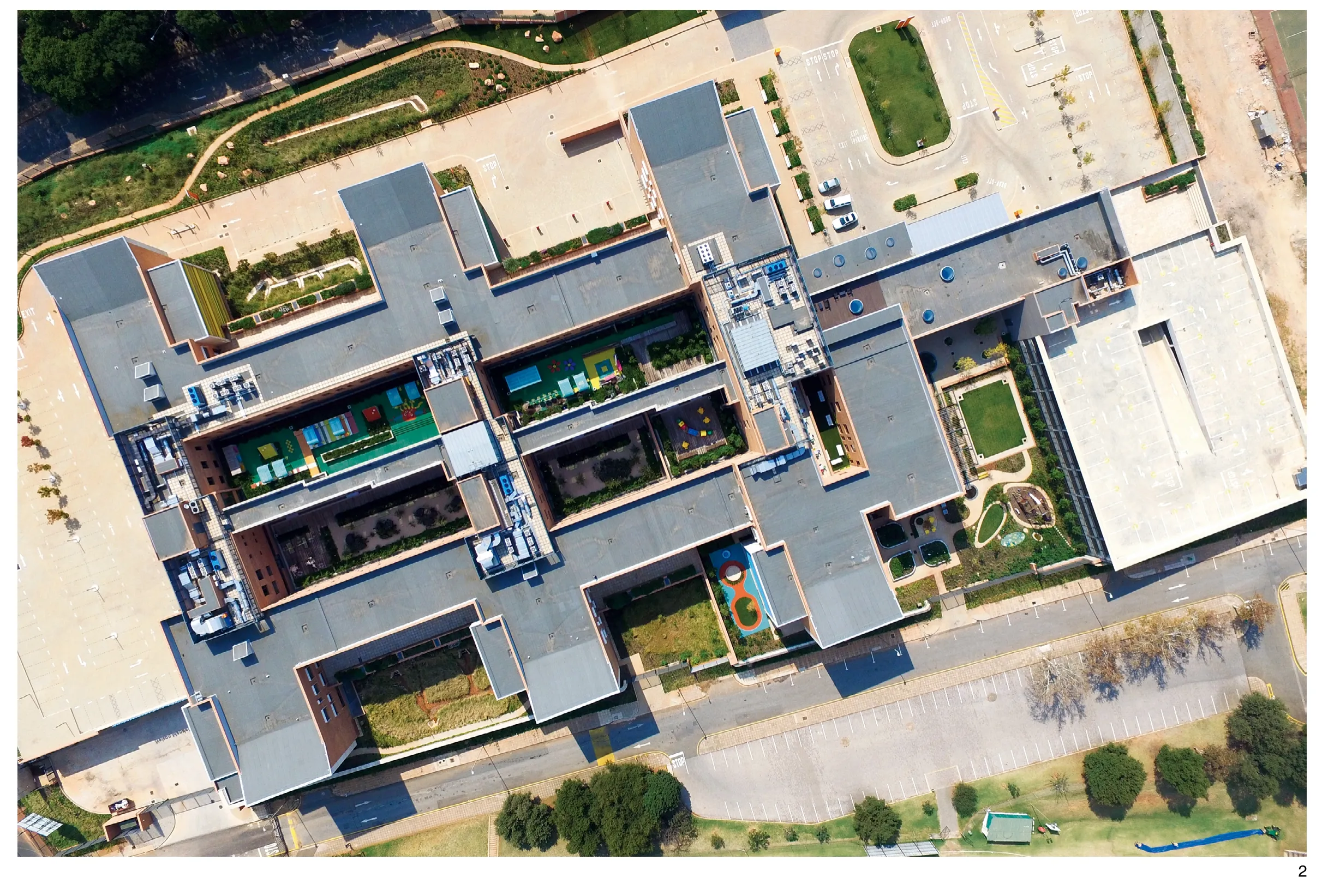
2 场地俯瞰Aerial view over site
项目介绍
医院景观通常由外围的“绿化”空间组成,但这对医院的环境和患者体验帮助甚少。在建筑竞赛中获奖的英国谢泼德·罗布森(Sheppard Robson)国际设计事务所,一改以前的刻板形象,将景观概念化,并以此作为建筑设计的核心。整体景观由5个内庭院和5个外庭院构成,5个内庭分两个层次,5个外部花园具有与医院治疗程序相关的特定功能。
外部花园
入口庭院形成了访客及病人对医院设施的第一印象。无论是对儿童还是他们的家人来说,参访医院都是一次压力很大的体验,因此景观设计旨在创造一个由彩色的标牌、舒适的座椅、高大的树木以及开花的植物营造的温馨环境。
游客花园始于接待区域,其目的是为了延续欢迎的气氛,包括一个俯瞰圆形池塘的咖啡厅露台、座位和可用于筹款活动的草坪空间。通道内设有狭窄的水渠,并由花架遮蔽,水渠将咖啡厅与庭院远处的儿童花园连接起来。 在这个空间里,年轻的访客将有机会远离医院环境的控制,释放压力。 游戏设施包括多彩的木制攀爬装置、滑梯、秋千、攀岩网和粉笔板,以及鸟澡盆和草堆。2个乘骑玩具是由艺术家布朗温·芬德利(Bronwyn Findlay)安装在描画昆虫和动物的彩色马赛克面板上。 在树丛间和攀爬装置下有艺术家温斯顿·卢丘里(Winston Luthuli)所设计的动物嬉戏雕塑。
感官花园(园艺治疗)和康复治疗花园为医院提供户外治疗的场所。园艺治疗让孩子们有机会积极地参与到大自然的循环过程中,通过种植、移植、除草、修剪和“收割”等一系列活动,将他们作为病人的角色转换为护理人员的角色。这些活动可以有效地减少压力并使孩子们更加快乐,从而更快地康复。在感官花园中设计的3层逐级抬升的种植池让儿童无论是站立或是坐在轮椅上都可以触摸到植物、嗅到花香并收割植物,设计师根据其感官特性精心挑选植物种类。可以在工作台上洗涤草药和蔬菜,同时工作台也提供了园艺工具的存放空间。带桌椅的小休息区可用于组织活动和非正式会议。
康复治疗花园的设计可以满足不同类型的身心治疗。该设计旨在满足广泛的功能需求,并从视觉上吸引儿童,以激励他们参与到特定的治疗项目中。 该区域的治疗元素包括沙坑、水上游泳池、橡胶轨道、乘骑玩具和可放置治疗设备的人造草坪。小的休息区可作为非正式会议和户外治疗的场地。
内部花园
5个内部景观庭院形成医院的“绿色核心”,可确保每位病人、访客和工作人员尽可能多地接触绿植和阳光。 庭院被分为3个活跃的和2个沉静的治疗庭院,每个空间的设计都受到周围医疗功能的影响。
日间、游戏和家庭花园(The Day - , Play -and Family Gardens )是位于一层的活跃的治疗庭院,大部分时间作为白天访客的等候和活动区域。在病人身体状况良好的情况下,也将鼓励他们与家人或陪护人员一同参观花园。
日间花园(Day garden)是一个靠近接待区的小庭院花园。 游客会被真实尺寸的火车雕塑互动玩具所吸引,玩具雕塑是由艺术家玛丽·西班德(Maria Sibande)设计的,被放置在树木环绕的木质平台上,树木茂密时为人们提供阴凉。游客可以在木制长凳和彩色座椅处休息。
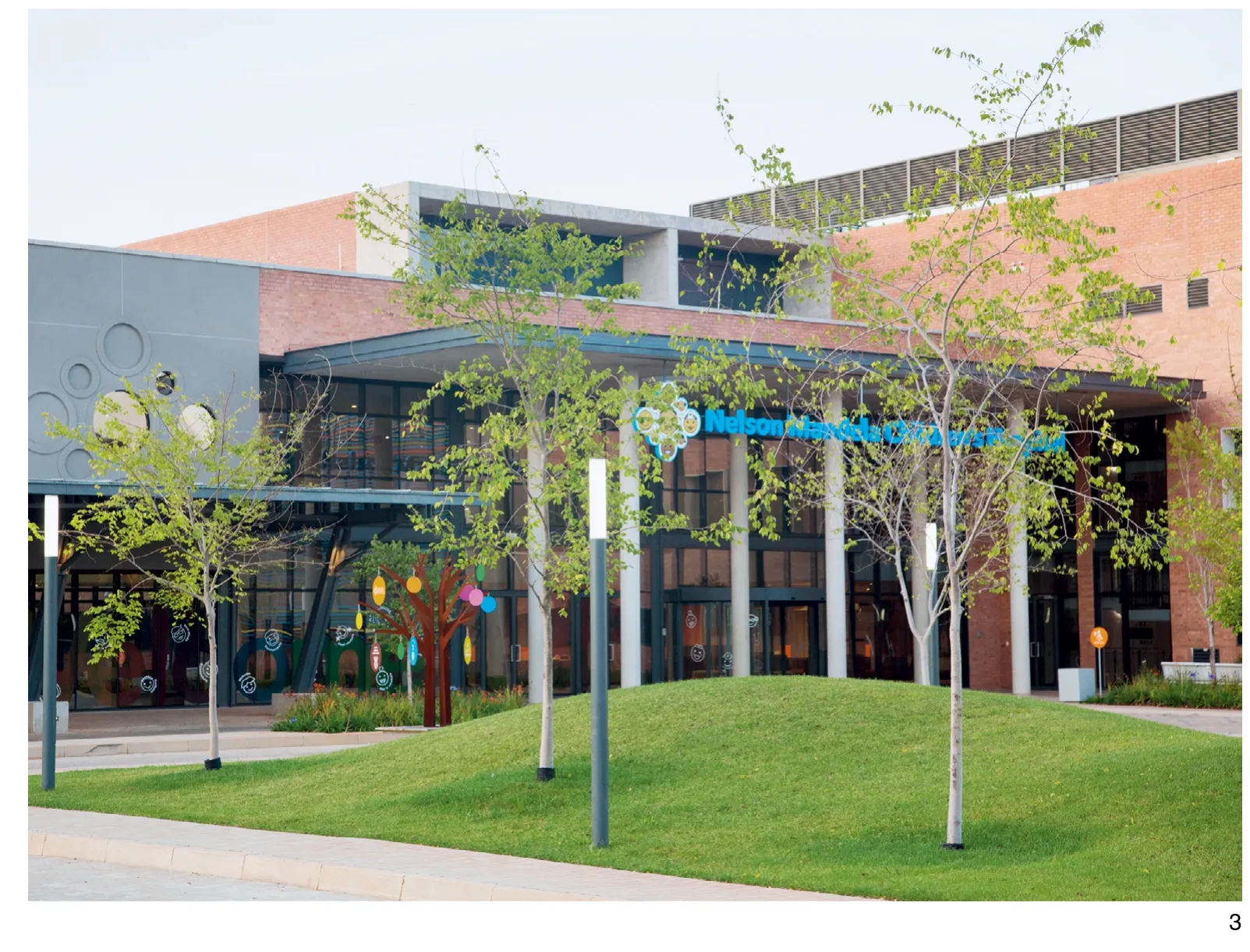
3 入口庭院
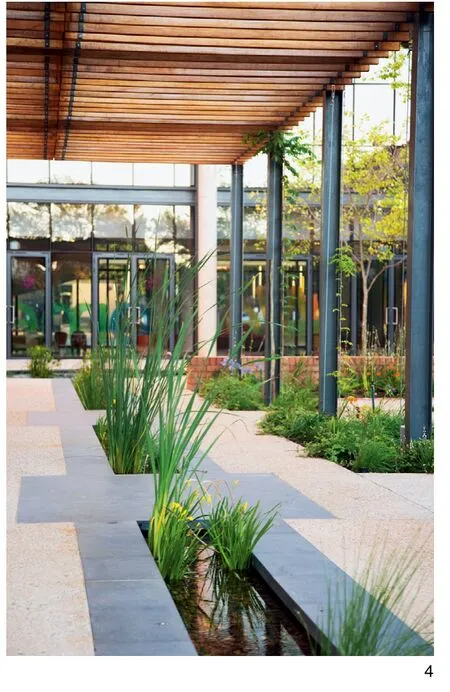
4 游客花园1Visitor Garden 1
游戏花园(Play Garden)(位于日间花园的对面)被分成一个略低于自然地面的平台和另一个略高的木质平台。日间花园中的木质铺装和树丛一直延续到游戏花园中的低平台,而稍高一点的平台则是多功能活动场地,被开花植物围合,并被橡胶游戏场地覆盖。孩子们可以在一个升高的互动水景中放置纸帆船,并且可以触到浅层的水和底层砂岩的轮廓。树屋(Tree House)是这个空间中的最大元素,是一个颇具特色的休息平台,必须通过梯子、猴子酒吧和篮子秋千才能到达。一个大型的Umlabalaba游戏棋盘被嵌入到橡胶地板中,游戏部件是由浇注型聚氨酯和木材组成的。孩子们可以在五彩缤纷的“毛毛虫(The Caterpillar)”画板上画画、写字,也可以滑动滑板轮制成的算盘玩耍。透过一楼窗户能看到由可移动的花瓣和圆形座椅创造出的图像和图案。
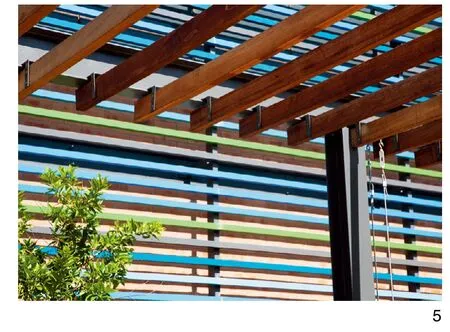
5 游客花园2Visitor Garden 2

6 游客花园3Visitor Garden 3
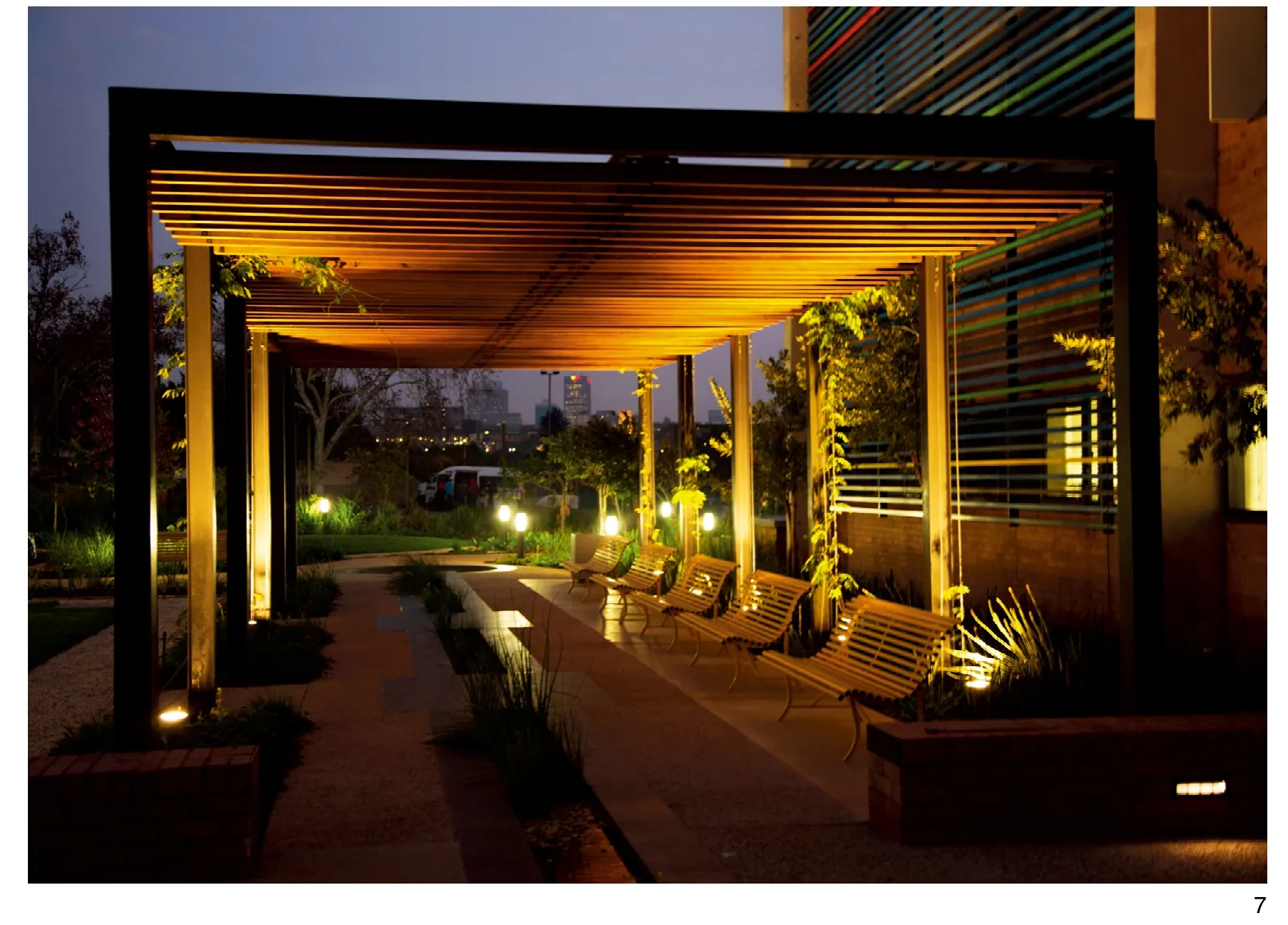
7 游客花园4Visitor Garden 4

8 儿童花园Children's Garden
家庭花园(Family Garden)在中心轴线的远端,也被分成一低一高的由开花植物围合的区域。地面由橡胶材料和彩色马赛克瓷砖铺成,嵌入橡胶地面的“怪物”欢迎着游客。这个怪物形象的灵感来自于一件黏土艺术品,这件艺术品是一个孩子在儿童基金赞助的研讨会中创作的。长凳上铺有五颜六色的马赛克瓷砖,自由摆放的家具和遮阳篷可为患者和游客创造舒适宜人的环境。“聊天室”是一个木质表皮的构筑物,被放置在遥远的角落里,为孩子们提供了3处多彩的对话和阅读空间。故事屏幕(The Story Screen)是被放置在北部边缘的一个雕塑网格结构。构成屏幕的一个个圆形要素都已经被嵌入插图(用激光在低碳钢上切割),用来展示探索和欢乐时刻的画面。插图中所绘制的图片由孩子们和20个当地艺术家在工作坊创造,全程由彩立方(Coloured Cube)设计公司和Assemblage设计公司共同赞助。
治疗花园和安静花园(Healing–and Quiet Garden)是两个宁谧的庭院花园,位于外科医院和重症监护病房旁的地下层。空间的设计目标是提供平静、有助于康复的环境,在这里病人及家属可以从紧张的环境中得到放松。
为了重新让花园的使用者近距离接触自然,根据其视觉和感官品质,会推敲每一寸表面和每一个元素的设计。茂盛的常绿植物围合出花园的缓冲区,为在花园和周边重症监护病房的病人们提供隐私空间和安全感。沿着每个庭院的长边放置雕刻的钢格子,从建筑内向外看时增加趣味性,同时也为一排舒适的长椅创造了一面视线通透的背景。
叶子形状的反光水池和落叶树被布置在浅砂岩砾石地面上。在叶状槽中注入水,从稍高一点的平台观察时,从斑驳的树冠中透射的阳光会反射在水面上。当树木茂盛时,树木将为庭院提供“绿色屋顶”,并将自然带给楼上的使用者。
安静花园(Quiet Garden)是最僻静的庭院,旨在为需要在自然环境中获得宁静的家庭成员提供休憩空间。一面庭院墙上展示的是由索韦托艺术女士马赛克合作社(the Soweto Art Ladies Mosaic Co-op)提供的6块马赛克板。这幅艺术品描绘了儿童创作“祝福贺卡”的活动画面,此活动是在儿童基金会赞助的研讨会期间举办的。 病人及家属可以在树枝上悬挂自己的祝福贺卡,从而进一步促进情绪恢复。
结论
这些康复花园的设计目的是为了缓解医院环境所带来的压力和创伤情绪。我们希望花园能够对孩子有足够的吸引力,并且希望在花园中的体验会给他们带来更多欢乐时刻。我们的目标是创造一个有助于儿童康复的景观,并为到访者和工作人员提供温馨和支持的空间。为致敬纳尔逊·曼德拉(Nelson Mandela)的一生,该项目(从概念到竣工)的目标一直是服务于南非的孩子们。
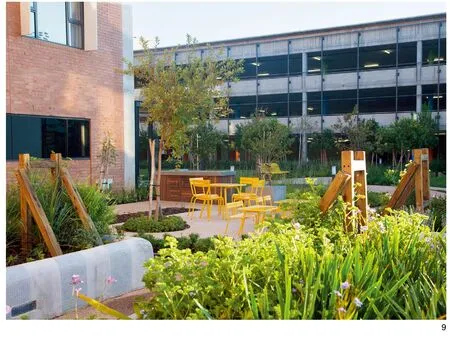
9 感官花园——前景的香料种植Sensory Garden—Fragrance planter in foreground
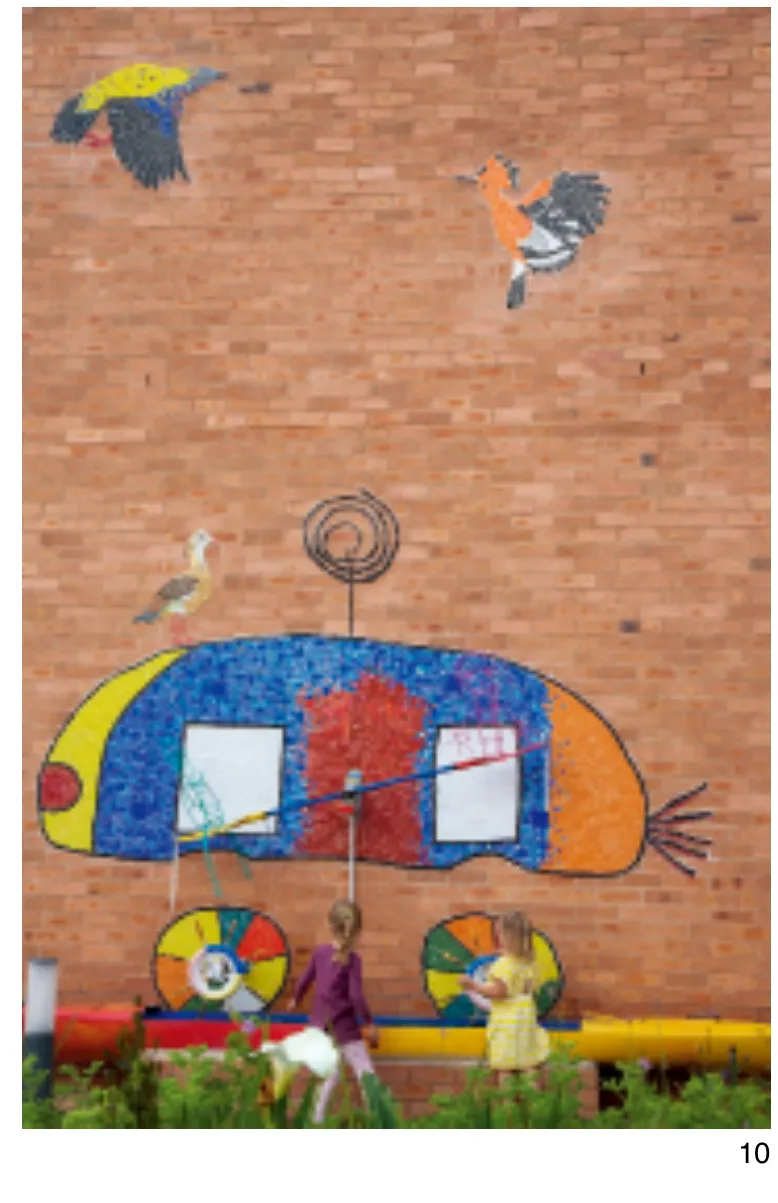
10 感官花园——互动水景Sensory Garden—Interactive water-feature
(编辑/刘昱霏)
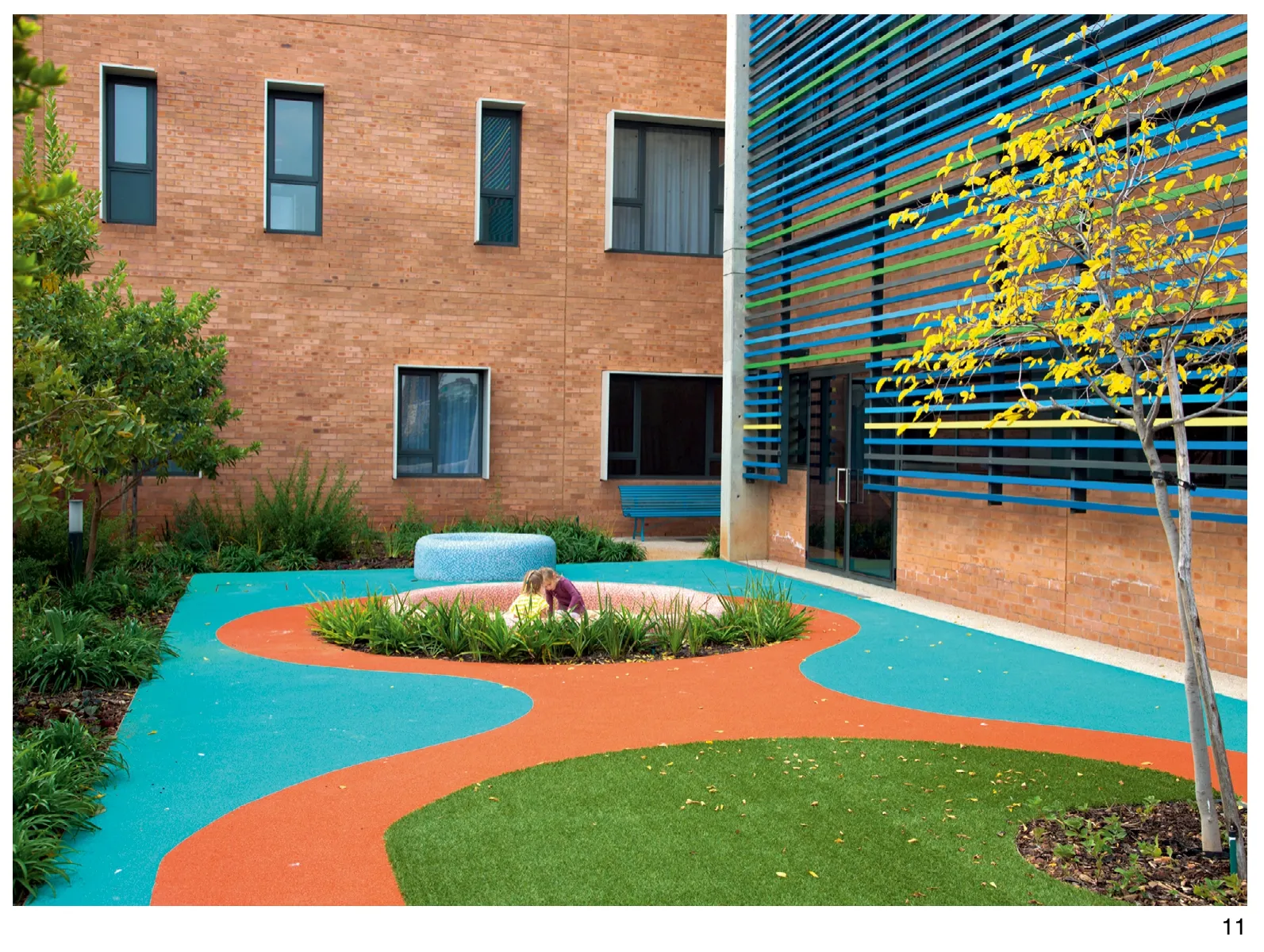
11 康复治疗花园Occupational Therapy Garden
项目信息:
地点:帕克镇,约翰内斯堡,豪登省,南非
客户:纳尔逊·曼德拉儿童医院信托机构
景观面积:22 000m²
项目团队:
景观设计:GREENinc景观设计公司
种植设计:景观设计师埃里卡·凡·伯格博士
建筑师:谢泼德·罗布森国际设计事务所,GAPP建筑师和规划师,约翰 ·库珀和鲁本·莱迪建筑师
主要承包商:五组公司
景观承包商:
景观分包商:生活景观设计公司
游乐设施:真实格调园林景观工程公司
钢制幕帘:螺旋工程设计公司
时间阶段:
设计和文件编辑分类:2015年6月—2016年3月
景观分包合同:2015年8月—2016年10月
直接签署合同:游乐设施,钢制幕帘与景观艺术:2016年7月— 2016年12月
项目竣工:2016年12月

12 日间花园——互动火车Day Garden—train sculpture
对景观建设的贡献者:
景观艺术:
艺术策划:邦吉·霍默
装置艺术项目经理:比埃·文特尔
室外景观:
动物雕塑:温斯顿·卢图利
感官花园互动水景:乌沙·席杰林与布朗温·芬德利合作完成
马赛克板:布朗温·芬德利
室内景观:
互动火车:玛丽·西班德(由Alan Epstein制造)
Umlabalaba游戏棋盘和算盘景观小品:彩立方设计公司
可活动的花朵形座椅:超级火力家具设计公司
故事屏幕钢装饰插图:彩立方设计公司与Assemblage设计公司合作完成
祝福贺卡的马赛克板:索韦托艺术女士马赛克合作社
道路指示牌:文森特·特鲁特——创意指导和寻路策略
卡丽娜·科姆里——创意指导与平面设计
卢·洛——项目和生产管理
珍妮·哈廷——DTP
设计协调:米歇尔·福斯特-黑鸟设计团队
翻译:李晶,胡一可
校对:唐彧玮
Background
During 2011, we joined the design team of the Nelson Mandela Children’s Hospital, a 200 bed specialist paediatric and academic tertiary referral hospital. This hospital envisioned by Nelson Mandela, relied solely on donor funding raised by the Nelson Mandela Children’s Fund. Construction was completed in May 2016 and the interior design phase in December 2016.
Therapeutic Landscapes
The landscape design of this hospital (as with the other hospitals in the GREENinc portfolio)is firmly based on the concept and principles of therapeutic landscape design. A landscape with therapeutic value is purposely designed in a way that encourages patients and their visitors to interactwith nature, in order to aid the process of healing. This choice to interact with nature, as well as making decisions while experiencing the garden,provides patients with a sense of control at a time when their health and wellbeing is in the control of others. In return, this sense of control, combined with the sensory benefits of being in a garden,physical activity and social interaction, results in a reduction in stress which ultimately leads to quicker recovery times and good health.
The successful design of a therapeutic landscape rests on four pillars namely: visual amp;physical accessibility to the landscape; ease of mobility for people with movement difficulties;a variety of functional spaces that meet different needs; and the provision of sensory stimulation. The knowledge and understanding of these principles,as well as consultation with our client, medical specialists and other design professional, guided us in all aspects of the therapeutic design process. We also explored the relatively new concept of Horticultural Therapy and hope that our efforts will result in this programme being offered by the hospital.
Project description
The typical hospital landscape usually consists of peripheral ‘green’ spaces that contribute little to the hospital environment and experience.The winning architectural competition entry by Sheppard Robson of the UK, ignored the stereotype and conceptualised the landscape as the centre of the building’s design.The landscape comprises of 5 internal courtyard gardens on two levels and 5 external garden spaces, with specific functions that relate to the programming of the hospital.
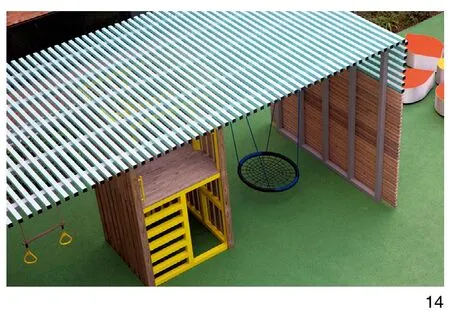
14 游戏花园——树屋Play Garden—Tree house
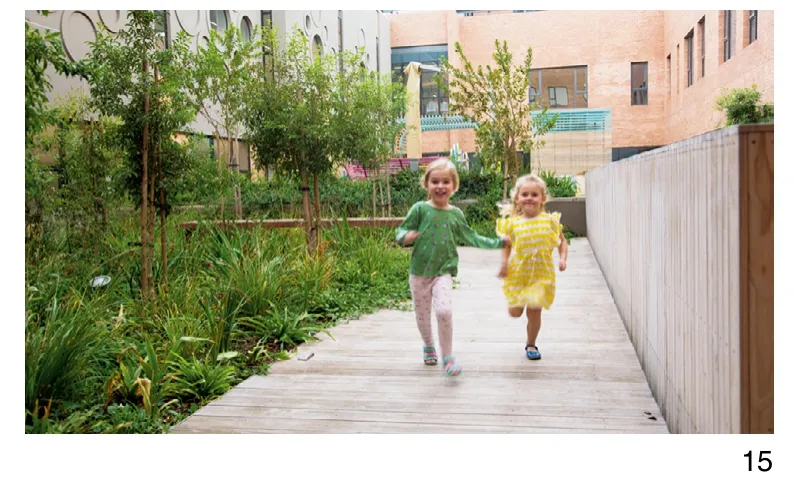
15 游戏花园2Play Garden 2
External Gardens
Visitors’ and patients’ fi rst impression of the facility will be formed by the Arrival Court. As a visit to a hospital is usually a stressful experience for children and their families, the landscape design aims to create a welcoming experience with elements such as colourful signage, comfortable seating, large trees and fl owering plants.
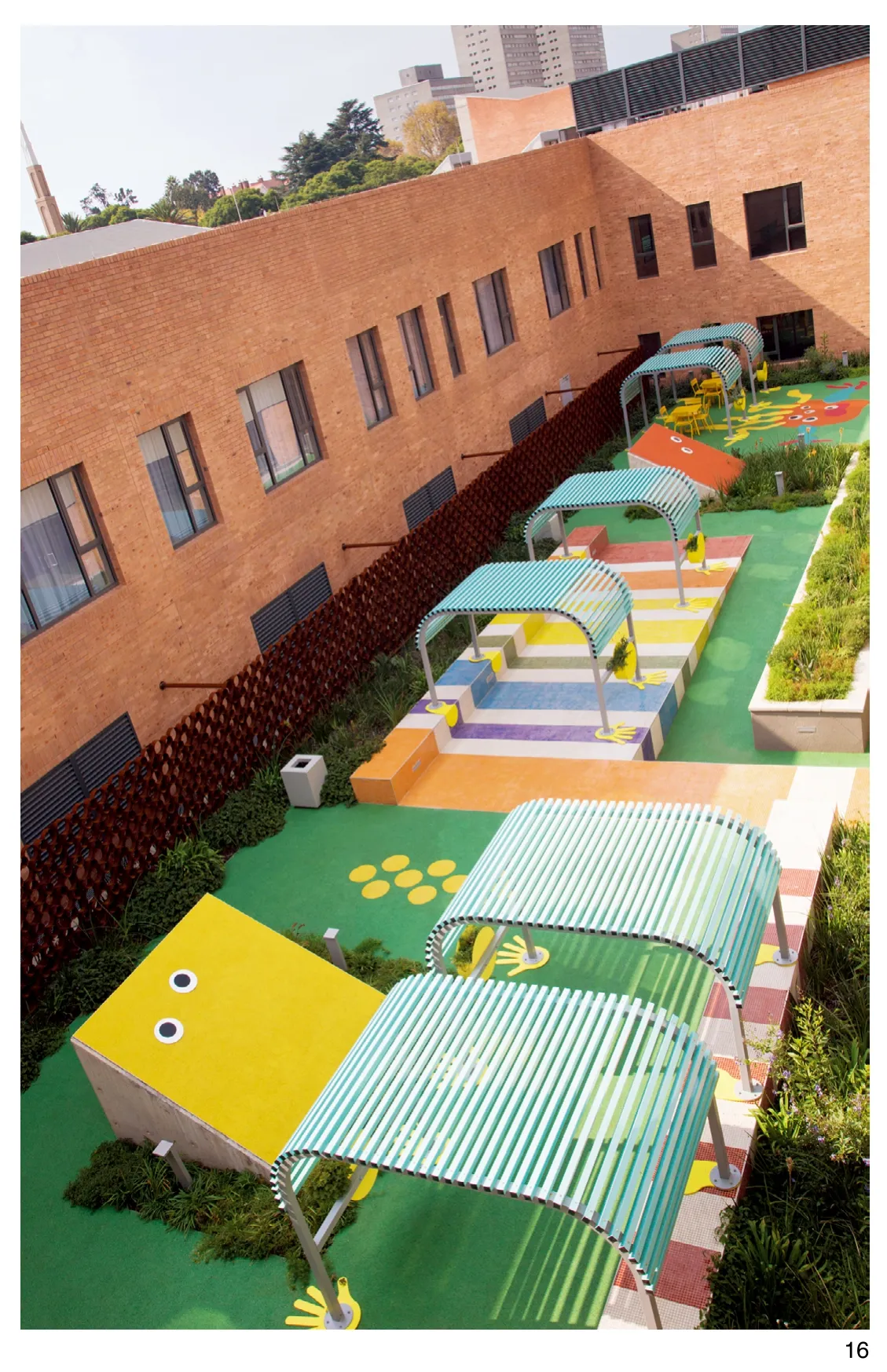
16 家庭花园1Family Garden 1
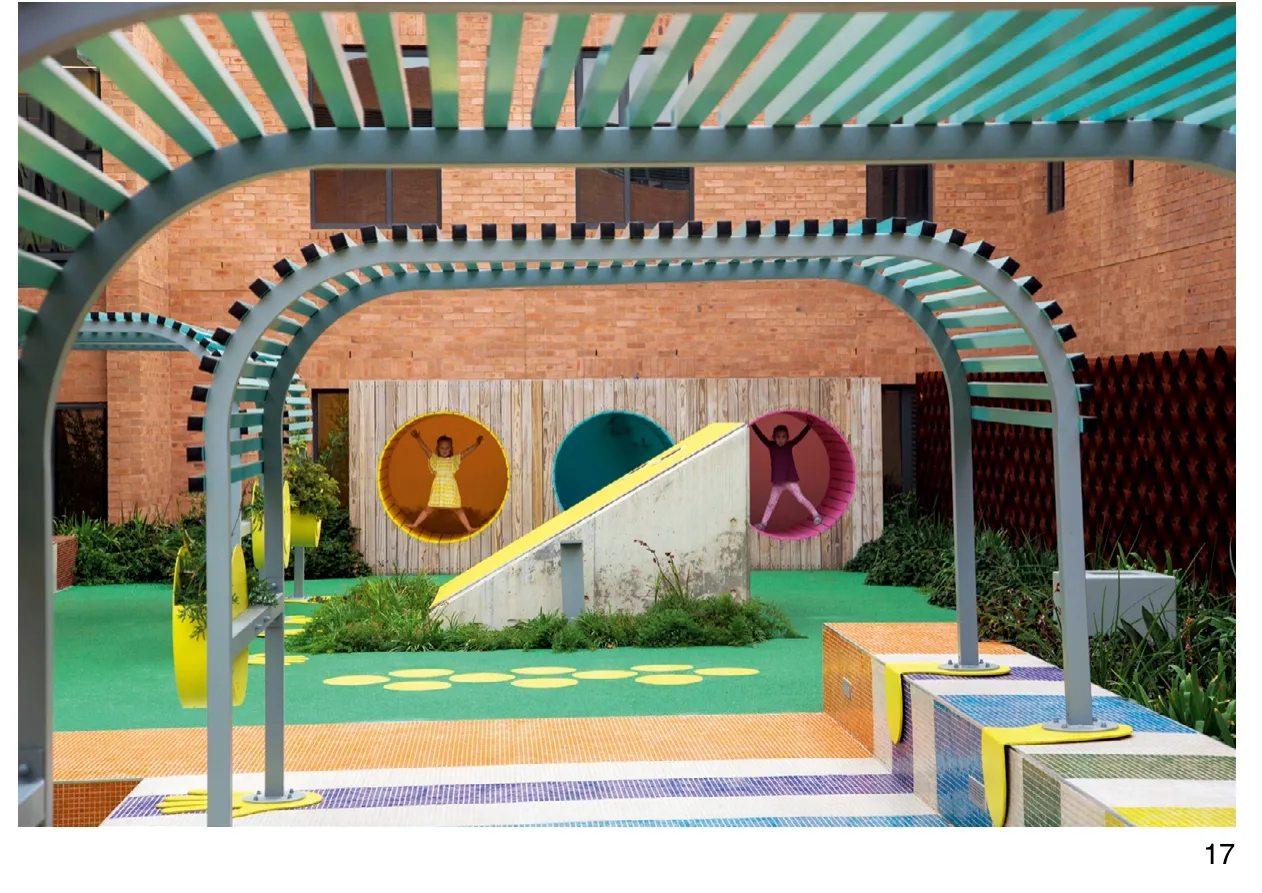
17 家庭花园2Family Garden 2
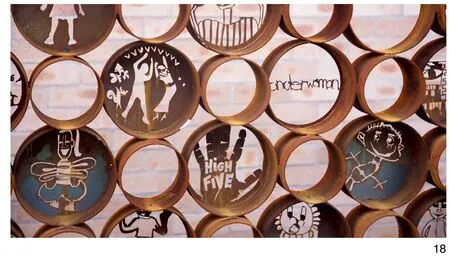
18 家庭花园——故事屏幕Family Garden—Story Screen
The Visitor Garden which leads from the reception areas, aims to provide a continuation of this welcoming experience. It includes a cafe terrace overlooking a circular pond, seating and a lawn area that can be utilised for fund-raising events.A narrow water channel set in a pathway and shaded by a pergola, connects the Café Terrace with the Children’s Garden at the far end of the courtyard. In this space, young visitors will have the opportunity to release pent-up energy away from the controlled hospital environment. The play elements include a colourful timber climbing structure with a slide, swings, a climbing net and a chalk-board,as well as a bird-bath and a mounded lawn. Two ride-on toys are mounted on a colourful mosaic panel depicting insects and animals, by artist Bronwyn Findlay.Playful sculptures of animals by artist Winston Luthuli are waiting to be discovered between the plants and under the climbing structure.
The Sensory Garden (Horticultural Therapy) and Occupational Therapy Garden will provide an outdoor venue for the therapy programmes offered by the hospital. Horticultural therapy gives a child the opportunity to actively participate in the cycle of nature and to substitute his/her role as patient with the role of care-giver, through activities such as planting, re-potting, weeding, pruning and‘harvesting’. These activities reduce boredom and stress, resulting in happier children that recover faster. The three raised planters in the Sensory Garden will allow children (standing or in wheelchairs) to easily touch, smell and harvest the plant material, which have been carefully selected for their sensory properties. Herbs and vegetables can be washed at a work bench which also provide storage space for gardening tools. The small seating area with tables and chairs can facilitate structured activities and informal meetings.
The design of the Occupational Therapy Garden can accommodate different types of psychological and physical therapies. The design aims to provide for a broad range of functional requirements and to appeal visually to children,in order to motivate them to take part in their prescribed therapy. Therapeutic elements in this space include a sand-pit, water-play-basin, rubberized tri-cycle track, ride-on toys and an arti fi cial lawn area where physical therapy equipment can be placed outdoors. A small seating area can be used for informal meetings and therapy sessions.
Internal Courtyard Gardens
The 5 internal landscaped courtyards form the ‘green heart’ of the hospital and will ensure that every patient, visitor and staff member will be exposed to as much greenery and natural light as possible. The courtyards have been grouped into 3 active – and 2 passive healing courtyard gardens and the design for each space has been in fl uenced by the nature of the surrounding hospital functions.
The Day - , Play - and Family Gardens are active courtyard gardens on the ground floor level and will mostly serve as outdoor waiting and activity areas for day visitors. In-patients who are well enough, will also be encouraged to visit the courtyard gardens with their family or care-givers.
The Day garden is a small courtyard garden close to the reception area. Visitors are drawn to this courtyard by a life-sized, interactive sculpture of a toy train, by artist Mary Sibande. The sculpture is placed on a timber deck surrounded by densely planted trees which will provide shade when mature. Timber benches and colourful tables with chairs provide seating.
The Play Garden (situated opposite the Day Garden) is divided into a lower terrace over natural ground and an upper terrace constructed over slab.The timber decking and forest like planting of the Day garden is continued on the lower terrace,while the upper terrace is a multi-functional activity space, framed by fl owering planting and covered by a rubberized play surface. A raised interactive water element, allows children to sail paper boats and to touch the shallow layer of water and underlying contoured sandstone surface. The largest element in the space is called the Tree House, as it features a seating platform that is reached by a ladder,monkey-bars and a basket-swing. An oversized Umlabalaba game board has been incorporated into the rubberized floor and the play pieces are made from cast polyurethane and wood. Children can draw and write on the colourful chalkboard structure named The Caterpillar and play with the abacus made from skateboard wheels. Movable seats in the shape of petals and circles can be moved around to create images and patterns that can be viewed from the fi rst fl oor windows.
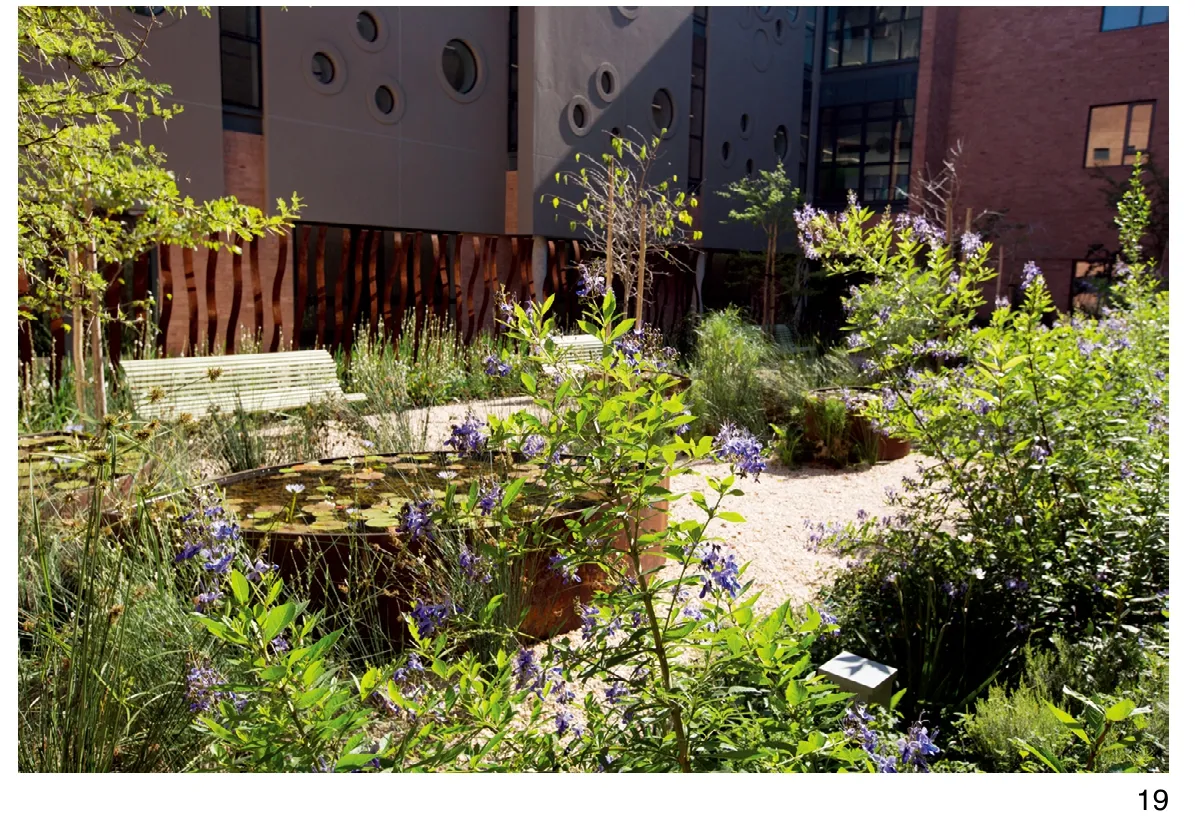
19 治疗花园1Healing Garden 1
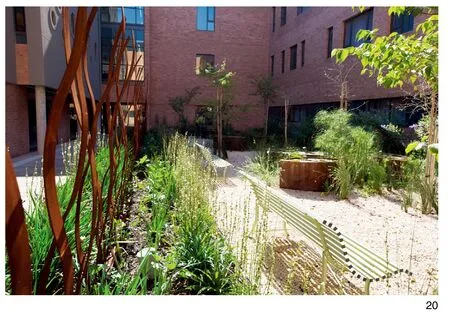
20 治疗花园——芦苇幕帘Healing Garden—Reed screen
The Family Garden at the far end of the Central Spine, is also divided into a lower - and an upper area and framed by fl owering planting. The floor surface is covered by rubberized flooring and colourful mosaic tiles. Visitors are welcomed to the upper terrace by a ‘monster’ embedded in the rubberized floor surface. The image of this monster was inspired by a clay artwork, created by a child during a workshop facilitated by the Children’s Fund. Benches tiled with colourful mosaic tiles, loose furniture and shade canopies create a comfortable experience for patients and visitors. Tucked into the far corner, a timber clad structure called The Chatroom features three colourful conversation amp; reading spaces for children. The Story Screen is a sculptural trellis structure placed along the northern edge of the space. Small vignettes (laser cut from mild steel)have been inserted into the circular components of the screen, to provide many moments of discovery and delight. The images depicted in the vignettes were created during a workshop with children amp;20 local artists, facilitated by The Coloured Cube in partnership with Assemblage.
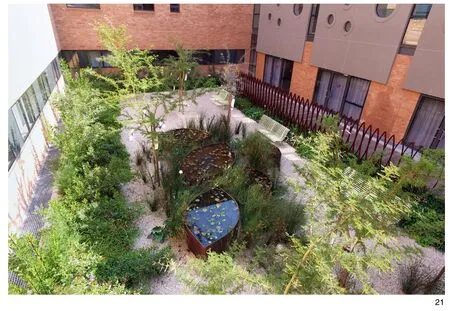
21 沉静花园Quiet Garden
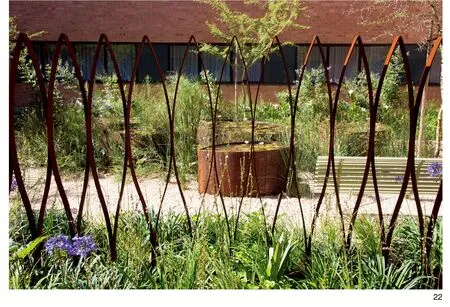
22 沉静花园——叶型幕帘Quiet Garden —Leaf Screen
The Healing - and Quiet Gardens are passive courtyard gardens, situated on the lower ground floor level next to the surgical theatres and the intensive care wards. The purpose of these spaces is to provide a peaceful amp; restorative environment,where family members can experience a reprieve from their stressful circumstances.
In an attempt to reconnect the occupants of the garden with nature, every surface and element were selected for its visual and sensory qualities.The gardens are framed by a dense buffer of evergreen planting, which provides a sense of privacy and security to the occupants of both the garden and the surrounding intensive care wards.A sculptural steel trellis placed along the length of each courtyard, adds interest when viewed from the building and also creates a permeable backdrop for a row of comfortable benches.
Leaf-shaped reflection ponds and deciduous trees are arranged on a light sandstone gravel fl oor surface. Water contained in leaf-shaped troughs,re fl ects the sun and shimmer through the dappled tree canopy when viewed from the upper floors.When mature, the trees will provide a ‘green roof’for the courtyard and will also bring nature to the occupants of the fl oors above.
The Quiet Garden is the most secluded courtyard and aims to provide a retreat for family members in need of quiet time in a natural setting.Displayed on one of the courtyard walls, are six mosaic panels by the Soweto Art Ladies Mosaic Co-op. The artworks depict ‘paper prayers’ created by children during a workshop facilitated by the Children’s Fund. Family members can hang their own paper prayers from the branches of the trees,to further facilitate emotional healing.
Conclusion
The purpose of these therapeutic garden spaces is to provide relief from the stress and emotional trauma of the hospital environment.We hope that the garden spaces will be inviting to children and that the experience will bring them many moments of joy. Our aim was to create a landscape that would aid in the convalescence of the children and that would provide welcoming,supportive spaces for visitors and members of staff. As a tribute to the life of Nelson Mandela, the intention of this project (from conceptualisation to completion) has been to serve the children of South Africa.
Project Information:
Location: Parktown, Johannesburg, Gauteng Province,South Africa
Client: Nelson Mandela Children’s Hospital Trust
Landscape area: 22000 m²
Project Team:
Landscape Architect: GREENinc Landscape Architecture
Planting Design: Dr. Erika van den Berg - Landscape Architect
Architect: Sheppard Robson International, GAPP Architects and Urban Designers, John Cooper and Ruben Reddy Architects
Main Contractor: Group Five
Landscape Contractors:
Landscape sub-contractor: Life Landscapes
Play Structures: Truestyle Hard Landscaping Solutions
Steel Screens: Spiral Engineering
Timeline:
Design amp; Documentation: June 2015—March 2016
Landscape sub-contract: August 2015—October 2016
Direct contracts: Play Structures, Steel Screens amp; Landscape Art: July 2016—December 2016
Project completion: December 2016
Contributors to the Landscape:
Art in the Landscape:
Art Curator: Bongi Dhlomo
Project Manager for art installation: Bié Venter
Exterior Landscape:
Animal sculptures: Winston Luthuli
Sensory Garden Interactive water feature:
Usha Seejarim in collaboration with Bronwyn Findlay
Mosaic panels: Bronwyn Findlay
Interior Landscape:
Interactive train: Mary Sibande (manufactured by Alan Epstein)
Umlabalaba play piecesamp; Abacus pieces: The Coloured Cube
Movable flower shaped seating: Spitfire Furniture amp; Design
Story Screen steel vignettes: The Coloured Cube in partnership with Assemblage
Paper Prayer mosaic panels: Soweto Art Ladies Mosaic Co-op.
Wayfinding Signage:
Vincent Truter—Creative Direction and Wayfinding Strategy Carina Comrie—Creative Direction and Graphic Design
Lou Louw—Project and Production Management Jenny Hattingh—DTP
Design Coordinator: Michelle Foster - Blackbird Design
Translator: LI Jing, HU Yi-ke
Proofreader: TANG Yu-wei
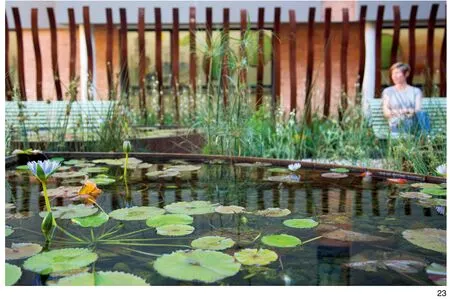
23 治疗花园2Healing Garden 2
The Landscape of the Nelson Mandela Children's Hospital
GREENinc Landscape Architecture

